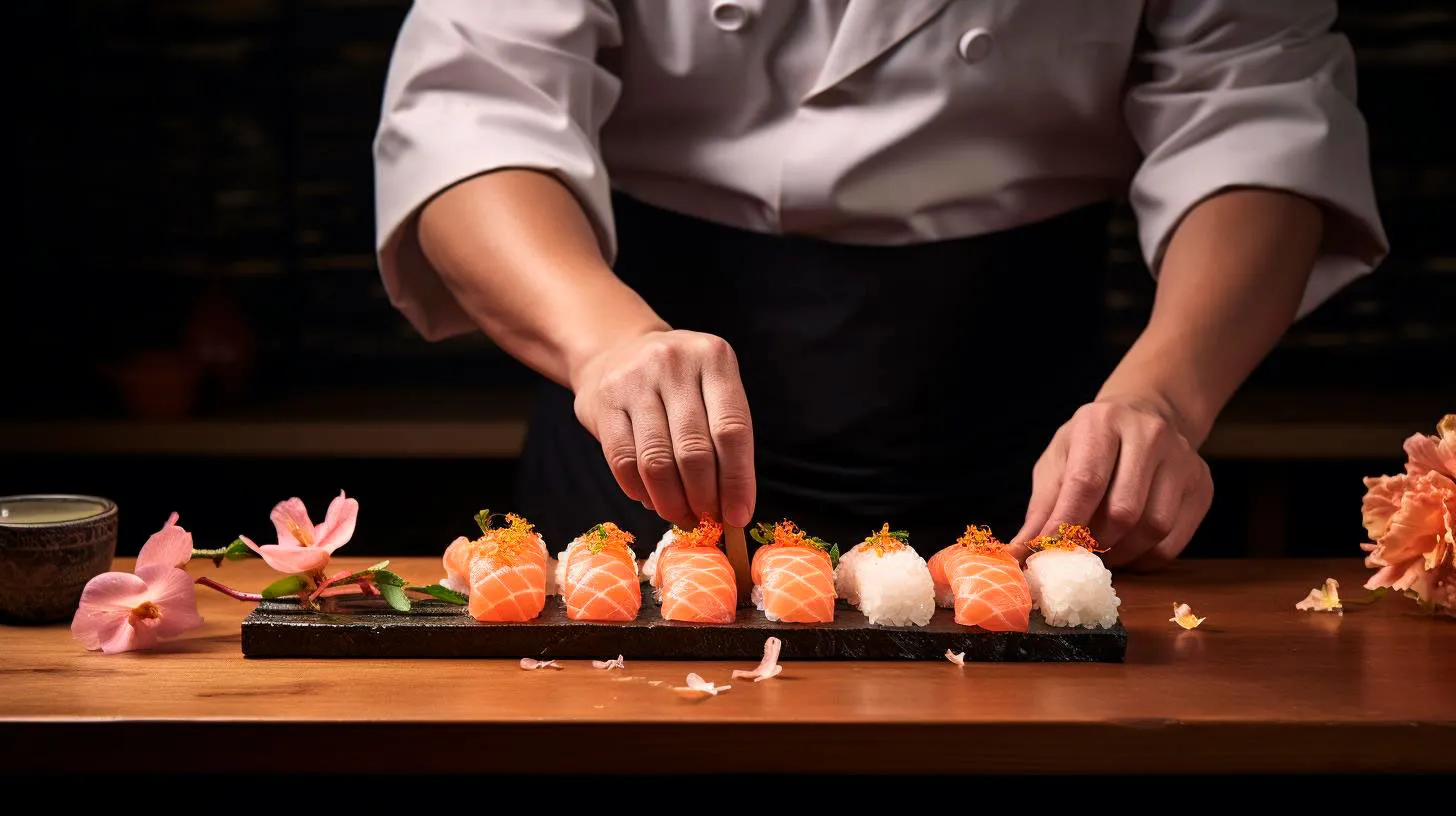From Sea to Table: The Fascinating Journey of Sushi
Join me as we delve into the fascinating world of sushi and explore its incredible journey from the sea to your table.
The Origins of Sushi
Sushi has its roots in Southeast Asia, where people preserved fish by fermenting it with rice. This technique was later introduced to Japan in the 8th century. Over time, sushi evolved and transformed into the delicacy we know today. Initially, sushi was served at food stalls as street food, but it gradually gained popularity and found its way onto restaurant menus.
The Ingredients
One of the key aspects of sushi is the freshness of its ingredients. Let’s take a closer look at the main components:
- Fish: Sushi is often associated with raw fish, but this is not always the case. Traditional sushi can also include cooked or marinated fish. Popular varieties of fish used in sushi include tuna, salmon, and yellowtail.
- Rice: Sushi rice is short-grained rice seasoned with vinegar, salt, and sugar. It has a sticky texture that allows it to hold its shape when rolled or pressed.
- Seaweed: Also known as nori, seaweed is used to wrap sushi rolls. It adds a unique flavor and texture to the dish.
- Vegetables: Sushi can also include a variety of vegetables such as cucumber, avocado, and radish, providing a refreshing crunch to each bite.
The Journey of Sushi
The journey of sushi starts with the fisherman casting their nets into the vast ocean. Let’s follow the path sushi takes on its way to your table:
1. Catching the Fish
Before sushi can be made, fresh fish needs to be caught. Fishermen venture into the open sea, braving the elements, to bring us the finest catch. This step ensures that sushi ingredients are of the highest quality and meet strict standards.
2. Transportation and Storage
Once caught, the fish is carefully handled and transported to ensure its freshness. Refrigerated trucks and containers maintain the optimal temperature, preserving the fish’s quality until it reaches the processing plants. Quick transport is crucial to avoid any deterioration in flavor and texture.
3. Processing and Preparation
At the processing plants, the fish is meticulously cleaned, filleted, and prepared for sushi. Skilled chefs use traditional techniques and tools to handle the fish with utmost precision. Each piece is inspected for quality, and only the finest cuts make it to your plate.
4. Rice Preparation
Simultaneously, sushi rice is prepared by expert chefs. They wash the rice, cook it to perfection, and season it with a mixture of vinegar, salt, and sugar. The rice is cooled and gently stirred to achieve the ideal texture and flavor.
5. Sushi Chefs at Work
Now comes the artistic part of sushi-making. Skillful sushi chefs create masterpieces by combining the prepared fish, rice, and other ingredients. They carefully roll the sushi, ensuring it holds together and presents an eye-catching appearance.
6. Delivery to Restaurants
Once the sushi is made, it is swiftly delivered to restaurants, where it awaits the eager taste buds of sushi enthusiasts. Delivery services play a crucial role in ensuring timely and efficient distribution, maintaining the freshness and quality of the sushi.
7. The Sushi Experience
Finally, it’s time for you to embark on your sushi journey. Whether you’re dining at a traditional restaurant or enjoying takeout, every bite of sushi is an experience in itself. The fusion of flavors, textures, and colors creates a tantalizing treat for your senses.
Key Takeaways
Now that you understand the journey of sushi, let’s summarize the key takeaways:
- Sushi originated in Southeast Asia and evolved into a popular Japanese dish.
- The main ingredients of sushi include fish, rice, seaweed, and vegetables.
- The journey of sushi involves fishing, transportation, processing, and skilled sushi chefs.
- Transportation and storage methods are crucial to maintaining the freshness of the fish.
- Artistic presentation and precise techniques are essential in sushi-making.
- Sushi delivery services help ensure timely distribution to restaurants.
- Enjoying sushi is a multisensory experience that delights food enthusiasts worldwide.
Next time you savor a piece of sushi, take a moment to appreciate the incredible journey it underwent before reaching your table. The craftsmanship, dedication, and attention to detail make sushi a true culinary masterpiece.
Preserving Heritage: How Ancient Sushi Ingredients Continue to Thrive Today
In this blog article, we’ll explore the ancient sushi ingredients that have stood the test of time and continue to thrive today.
The Timeless Elegance of Sushi
Sushi has a rich history that dates back to the 8th century in Japan. Originally, it was a way to preserve fish by fermenting it with rice. The fermented rice was discarded, and the preserved fish was eaten when needed. Over time, this preservation method evolved, and sushi as we know it today emerged.
Despite the advancements in technology and culinary techniques, traditional sushi-making has remained relatively unchanged. The focus is still on sourcing the highest quality ingredients and preparing them with precision and care. Let’s delve into the key sushi ingredients that continue to play a vital role in this culinary tradition.
1. Rice: The Foundation of Sushi
Japanese short-grain rice, known as Japonica rice, is the essential ingredient in sushi. It has a slightly sweet and sticky texture, which allows it to be molded into various shapes and hold the toppings in place. The rice is cooked with vinegar, salt, and sugar to impart a distinct flavor.profile.
- Key takeaway: The quality of sushi largely depends on the rice used. It should have the right balance of stickiness and flavor.
2. Fish and Seafood: Freshness is Paramount
The freshness of the fish and seafood used in sushi is crucial to its taste and safety. Chefs meticulously select the finest cuts, often relying on local and seasonal varieties. Tuna, salmon, yellowtail, and shrimp are some of the most popular choices.
- Feature: Sashimi-grade fish is carefully handled and frozen at ultra-low temperatures to ensure any parasites are eliminated.
- Advantage: Sushi offers a delectable way to consume nutrient-rich fish and seafood, providing essential Omega-3 fatty acids and other vital nutrients.
- Key takeaway: The quality and freshness of the fish impact the overall flavor and safety of the sushi.
3. Seaweed: The Versatile Wrapper
Nori, a type of edible seaweed, is used to wrap many types of sushi. It provides a delicate texture and adds a savory umami flavor to the dish. Nori is roasted and seasoned with salt before being used as a wrapper.
- Feature: Nori is a rich source of vitamins, minerals, and antioxidants, including iodine, calcium, and vitamins A and C.
- Advantage: The use of seaweed in sushi boosts its nutritional profile and adds a unique taste to each bite.
- Key takeaway: Nori plays a significant role in the flavor and presentation of sushi.
4. Wasabi: The Fiery Green Paste
Wasabi, a pungent green paste made from the root of the Wasabia japonica plant, is a staple condiment in sushi. Its strong, distinctive flavor provides a pleasing contrast to the richness of the fish.
- Feature: Wasabi possesses antimicrobial properties and may offer certain health benefits, such as aiding digestion and combating foodborne illnesses.
- Advantage: Adding a small amount of wasabi to your sushi can enhance the flavors and provide potential health benefits.
- Key takeaway: Wasabi brings a fiery kick and potential health benefits to your sushi experience.
Preserving Ancient Traditions for Modern Palates
While sushi has undoubtedly evolved to accommodate diverse tastes and dietary preferences, its traditional ingredients remain the backbone of this gastronomic marvel. Preserving these ancient ingredients not only pays homage to Japan’s culinary heritage but also ensures that sushi aficionados worldwide can indulge in the authentic flavors and textures that have mesmerized generations.
From century-old sushi establishments in Tokyo to modern sushi bars in cosmopolitan cities, the commitment to preserving sushi’s essence remains unwavering. So, the next time you savor a piece of nigiri or a beautifully crafted sushi roll, take a moment to appreciate the ancient and timeless ingredients that continue to shape this beloved culinary tradition.
Unveiling the Secrets: Exploring Ancient Ingredients in Contemporary Sushi
Ancient Ingredients: A Glimpse into Sushi’s History
In order to truly understand the secrets behind contemporary sushi, it is essential to delve into its origins. Sushi first emerged in Southeast Asia as a means of preserving fish in fermented rice. This method allowed the fish to be stored for months, providing a valuable source of protein during times when fresh catch was not readily available.
Over time, sushi made its way to Japan and evolved into the form we recognize today. The Japanese refined the art of sushi-making, introducing various ingredients to enhance flavors and textures. While modern sushi has expanded to include countless variations, it still pays homage to its roots through the use of ancient ingredients.
Exploring Key Ancient Ingredients in Contemporary Sushi
1. Nori: This seaweed is an essential component of sushi rolls, providing a salty and slightly sweet taste. Rich in vitamins and minerals, nori adds depth of flavor and offers a nutritious element to the dish. It is also a great source of iodine, which is vital for maintaining a healthy thyroid function.
2. Wasabi: Known for its pungent and fiery flavor, wasabi is a staple condiment in sushi cuisine. This green paste is derived from the Wasabia japonica plant and, in addition to adding a kick of heat, it also possesses antimicrobial properties that can help reduce the risk of foodborne illnesses.
3. Soy Sauce: While soy sauce may seem commonplace, it plays a crucial role in enhancing the flavors of sushi. Made from fermented soybeans, this umami-rich sauce adds depth and balances the taste of the fish and rice. It also contains antioxidants and essential amino acids that contribute to overall health.
4. Pickled Ginger: A common accompaniment to sushi, pickled ginger acts as a palate cleanser between bites. This tangy and refreshing ingredient helps to cleanse the palate, preparing it for the different flavors and textures in each sushi roll. Ginger is also known for its digestive benefits and anti-inflammatory properties.
Advantages of Incorporating Ancient Ingredients
While contemporary sushi has limitless possibilities when it comes to ingredients, incorporating ancient elements provides several advantages:
- Preserved Tradition: Including ancient ingredients helps to preserve the authenticity and historical significance of sushi.
- Rich Flavor Profiles: Ancient ingredients add depth, complexity, and unique flavors that elevate the overall taste experience.
- Health Benefits: Many ancient ingredients in sushi possess nutritional qualities that promote overall well-being.
- Cultural Appreciation: By utilizing ancient ingredients, sushi celebrates Japanese culture and pays homage to its culinary heritage.
Key Takeaways
Sushi, a beloved delicacy admired worldwide, owes its distinctive flavors and textures to its ancient ingredients. Whether it’s the umami-rich soy sauce, the vibrant nori, or the fiery wasabi, each component adds its own layer of complexity, culture, and health benefits. By embracing these ancient secrets, contemporary sushi pays homage to its roots while simultaneously evolving and captivating the taste buds of modern food enthusiasts.
Timeless Flavors: Traditional Ingredients that Define Modern Sushi
This article delves into the timeless flavors and traditional ingredients that define modern sushi.
Modern sushi is an amalgamation of traditional Japanese cooking techniques combined with contemporary influences. The word sushi itself refers to the vinegared rice that is a staple component of this dish. However, sushi is incomplete without the addition of various fillings, known as neta, which include fish, seafood, vegetables, and more.
The Essential Ingredients for Perfect Sushi
Several key ingredients contribute to the flavors and textures that make modern sushi so unique. Let’s explore them:
- Nori: This edible seaweed is a vital part of sushi. It provides a delicate and slightly salty flavor that complements the other ingredients.
- Shari: The vinegared rice, known as shari, acts as the foundation of sushi. It is meticulously prepared by blending rice with rice vinegar, salt, and sugar, resulting in a subtly sweet and tangy taste.
- Sashimi: Sashimi refers to thin slices of raw fish or seafood, and it is one of the most popular types of neta used in sushi. From options like tuna and salmon to more exotic choices like eel or octopus, sashimi offers a burst of fresh and delicate flavors.
- Vegetables and Fruits: Modern sushi is not limited to seafood and fish. Various vegetables and fruits like avocado, cucumber, asparagus, and mango are used as fillings. They add a delightful crunch and a burst of vibrant flavors to the sushi rolls.
- Wasabi and Soy Sauce: Wasabi, a spicy Japanese horseradish, and soy sauce are often served alongside sushi. Wasabi lends a pungent heat, while soy sauce provides an umami-rich and savory taste.
The Advantages of Traditional Ingredients in Modern Sushi
While modern sushi has undoubtedly evolved, the inclusion of traditional ingredients continues to play a significant role. Here are some advantages:
- Rich Flavor Profile: Traditional ingredients add depth and complexity to sushi, creating a diverse flavor profile that keeps diners coming back for more.
- Cultural Heritage: By incorporating traditional ingredients, modern sushi pays respect to its cultural roots and keeps the essence of Japanese cuisine alive.
- Freshness and Quality: Traditional sushi ingredients are often sourced fresh, ensuring that each bite is a testament to the quality and freshness of the ingredients used.
Key Takeaways for Sushi Lovers
To truly appreciate modern sushi, keep the following key takeaways in mind:
- Sushi is a fusion of traditional Japanese cooking techniques and contemporary influences.
- The essential ingredients of sushi include nori, vinegared rice, sashimi, fruits, vegetables, wasabi, and soy sauce.
- Traditional ingredients contribute to a rich flavor profile and play a crucial role in upholding the cultural heritage of sushi.
- Freshness and quality are paramount in modern sushi, ensuring a delightful dining experience.
Embrace the timeless flavors and traditional ingredients of sushi, and embark on a culinary journey that celebrates the harmony of taste, texture, and culture.



